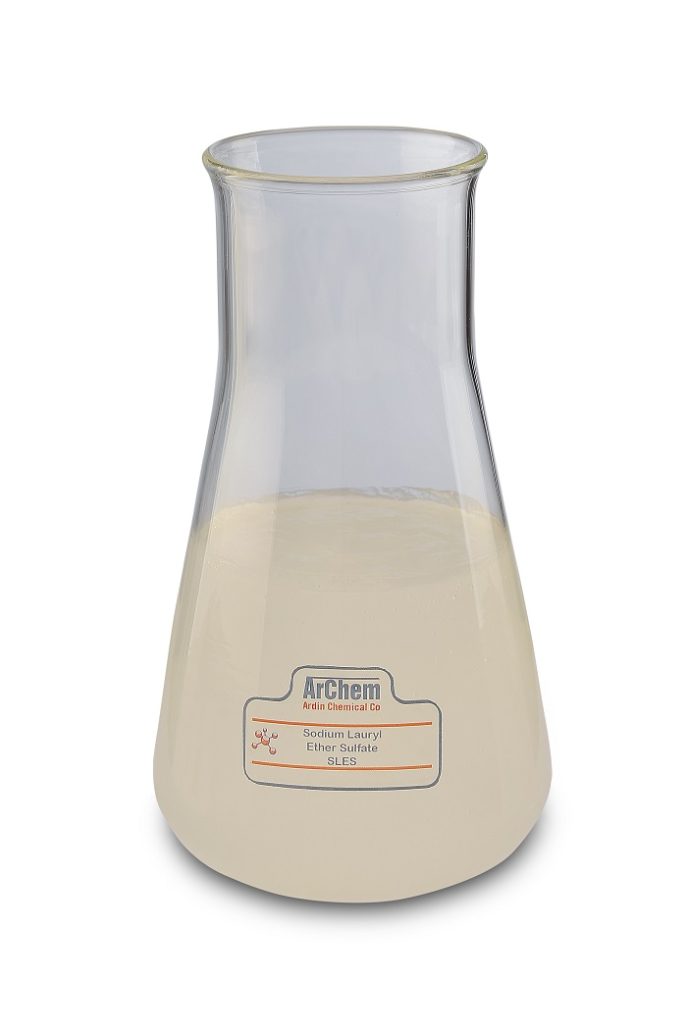Sodium Laureth Sulfate (SLES) is a yellow-white paste with the chemical formula C14H29NaO5S. it is an anionic surfactant widely used in many personal care products like shampoo, toothpaste, hand wash, and cosmetics. The aqueous solution of commercial products usually contains 30 to 70% SLES.
ArChem provides SLES and other raw chemical materials such as Sodium Nitrate, Soda Ash, and Ammonium Chloride for various industrial applications. Additionally, ArChem provides customers with other chemical products including Nitrocellulose, Nitrocellulose solution, organic solvents, etc. for further information please contact our technical sales team in ArChem.


Archem Sodium laureth sulfate (also known as SLES, Sodium Lauryl Ether Sulfate, Dodecyl sodium ethoxysulfate, and Sodium lauryl oxyethyl sulfate) is an anionic detergent and surfactant found in many personal care products. Additionally, this product is a very effective foaming agent, especially in industrial applications. The main attributes of Archem SLES are listed below:
Archem SLES is a surfactant that lowers the surface tension between the ingredients, and due to this property, it is a good cleansing and foaming agent. Plus, the minimum degree of skin irritation and insensitivity to hard water makes it the ideal component in different personal care products. The chemical and physical properties of ArChem SLES are listed below:
| Molecular Formula | C14H29NaO5S |
| IUPAC name | Sodium 2-(2-dodecyloxyethoxy) ethyl sulphate |
| Cas Number | 9004-82-4 |
| Molecular weight | 288.3 g/mol |
| Density | 1.01 g cm–3 |
| Boiling Point | 288.4 °C |
| Flashpoint | >93 °C |
| Melting Point | 206 °C |
| Flammability | Combustible |

SLES is inexpensive, has great cleaning properties, and acts as a great foaming agent. So it is suitable for use in cosmetic products to perform emulsification and cleaning. Some uses of ArChem SLES include:
The chemical reaction of Lauryl alcohol with petroleum or oil (palm oil and coconut oil) produces Sodium Lauryl Sulfate (SLS). Then, to obtain SLES from SLS, it should react with ethylene oxide. This process is known as ethoxylation.
Storage conditions of ArChem SLES are listed below:
The severity of the symptoms will vary dependent on the concentration and the length of exposure. Some of necessary first-aid measures are described as below:
Operators should wash their hands before breaks and after work. they should use personal protective types of equipment and wear chemical impermeable gloves when handling SLES to avoid contact with the body, skin, and eyes.
SLES is mostly used in the production of industrial cleaners, emulsifiers, detergents, dish wash detergents, and general cleaners.
Sodium laureth sulfate (SLES), is also known as Sodium Lauryl Ether Sulfate, Dodecyl sodium ethoxysulfate, and Sodium lauryl oxyethyl sulfate.
ArChem raw chemical materials can be purchased in a variety of volumes. Depending on your orders, Prices are different. for more information, please contact our technical sales team in ArChem.
The CAS number of SLES is 9004-82-4.
The HS code of SLES is 34021100.